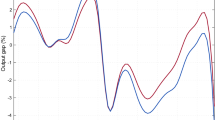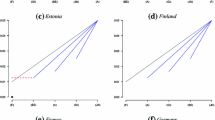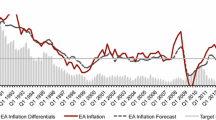Abstract
This paper examines the empirical performance of the New Keynesian Phillips curve and its hybrid specification in the euro area. Instead of imposing rational expectations, direct measures, i.e. OECD forecasts, are used as empirical proxies for economic agents’ inflation expectations. Real marginal costs are proxied by three alternative measures. The results suggest that once the rational expectations hypothesis is relaxed and directly measured expectations are used, the European inflation process can be modeled using the forward-looking New Keynesian Phillips curve. However, when allowing for possible non-rationalities in expectations, inflation can be modeled more accurately by the hybrid Phillips curve with the additional lagged inflation term. In this approach, output gap turns out to be at least as good as labor income share as a proxy for real marginal cost. Moreover, the inflation process seems to have become more forward-looking in the recent years of low and stable inflation.
Similar content being viewed by others
References
Adam K, Padula M (2003) Inflation dynamics and subjective expectations in the United States. European Central Bank Working Paper Series, No. 222
Artis MJ (1996) How accurate are the IMF’s short-term forecasts? Another examination of the world economic outlook, staff studies of the world economic outlook. IMF, Geneva
Ash JCK, Smyth DJ, Heravi SM (1998) Are OECD forecasts rational and useful? A directional analysis. Int J Forecast 14:381–391
Ball LS (2000) Near-rationality and inflation in two monetary regimes. NBER Working Paper No. 7988
Calvo GA (1983) Staggered prices in a utility-maximizing framework. J Monetary Econ 12:383–398
Fuhrer JC (1997) The (un)importance of forward looking behavior in price specifications. J Money Credit Bank 29(3):338–350
Galí J, Gertler M (1999) Inflation dynamics: a structural econometric analysis. J Monetary Econ 44:195–222
Galí J, Gertler M, López-Salido JD (2001) European inflation dynamics. Eur Econ Rev 45:1237–1270
King RG (2000) The new IS-LM model: language, logic, and limits.Econ Q 86(3):45–103
Neiss KS, Nelson E (2002) Inflation dynamics, marginal cost, and the output gap: Evidence from three countries. J Money Credit Bank (in press)
Öller L-E, Barot B (2000) The accuracy of European growth and inflation forecasts. Int J Forecast 16:293–315
Pons J (2000) The accuracy of IMF and OECD forecasts for G7 countries. J Forecast 19:53–63
Roberts JM (1997) Is inflation sticky? J Monetary Econ 39:173–196
Roberts JM (1998) Inflation expectations and the transmission of monetary policy. Board of Governors of the Federal Reserve System
Roberts JM (2001) How well does the New Keynesian sticky-price model fit the data? Federal Reserve Board, Finance and Economics Discussion Series, 2001–13
Rotemberg J (1982) Monopolistic price adjustment and aggregate output. Rev Econ Stud 49(158):517–531
Rudd J, Whelan K (2002) Should monetary policy target labor’s share of income? Federal Reserve Board, Div. of Research and Statistics
Sbordone AM (2002) Prices and unit labor costs: a new test of price stickiness. J Monetary Econ 49:265–292
Taylor J (1980) Aggregate dynamics and staggered contracts. J Polit Econ 88:1–23
Walsh CE (1998) Monetary theory and policy. The MIT Press, Cambridge
Woodford M (2003) Interest and prices. Princeton University Press, New Jersey
Author information
Authors and Affiliations
Corresponding author
Additional information
The views expressed are those of the author and do not necessarily reflect the views of the Bank of Finland. Special thanks are due to the editor, two anonymous referees, Juha Tarkka, Jouko Vilmunen and Matti Virén for useful comments. I am also grateful to David Mayes and Geoffrey Wood for helpful suggestions and to Heli Tikkunen for excellent research assistance. For their constructive comments, I would also thank participants in the conference on the Eurosystem Inflation Persistence Network at the ECB, which was held in Frankfurt in December 2003.
Rights and permissions
About this article
Cite this article
Paloviita, M. Inflation Dynamics in the Euro Area and the Role of Expectations. Empirical Economics 31, 847–860 (2006). https://doi.org/10.1007/s00181-006-0057-6
Received:
Accepted:
Published:
Issue Date:
DOI: https://doi.org/10.1007/s00181-006-0057-6




